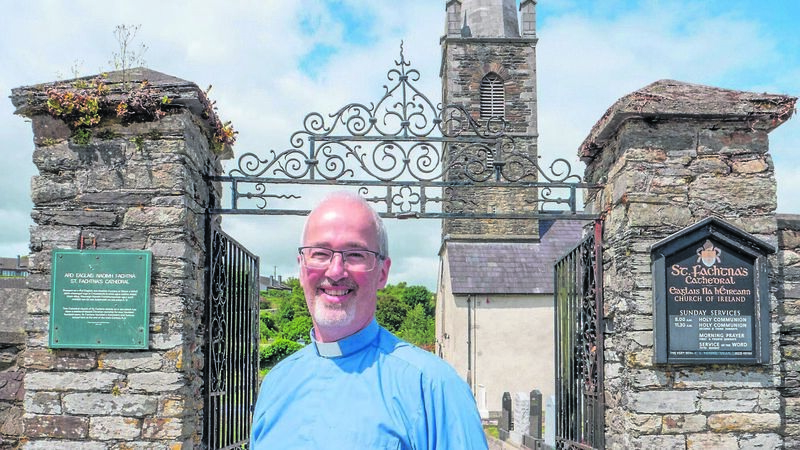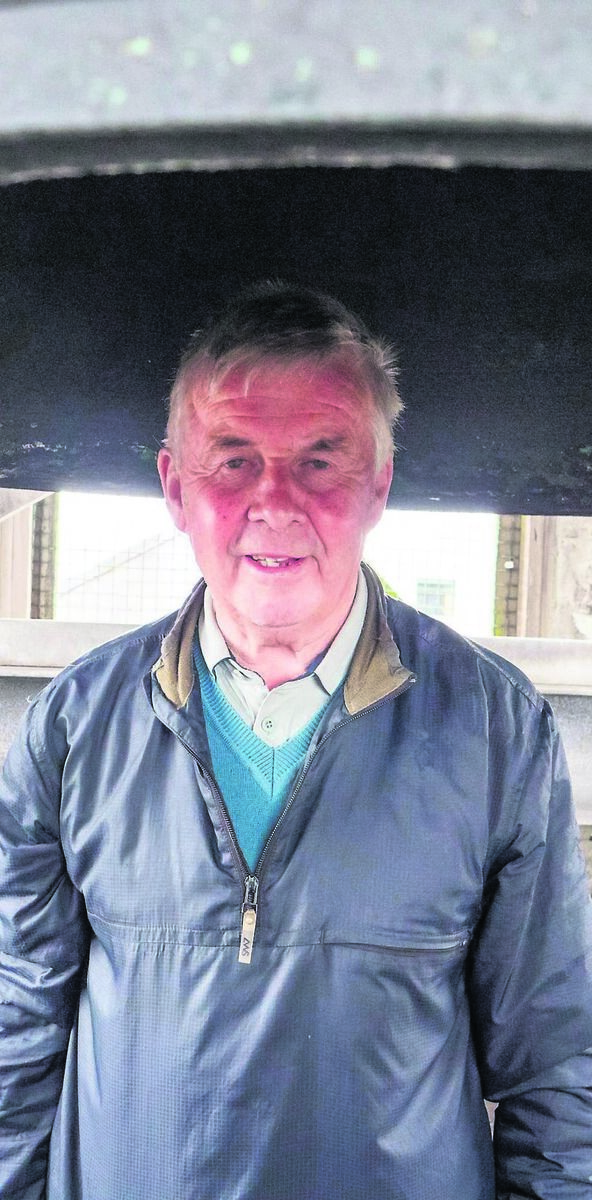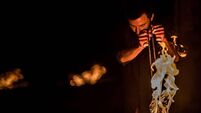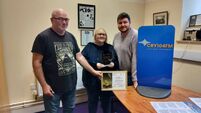VIDEOS: Could you become a bell ringer in Cork?

Cliff Jeffers outside St Fachtna’s Cathedral in Rosscarbery.
CORK is as much known for its sounds as it is for its red and white colours.
The bell sounds heard from the likes of St Anne’s Church in Shandon or St Fin Barre’s Cathedral are synonymous with Cork and interwoven to the city’s fabric. Other bells ring out in towns and villages across the county.
One might imagine these sounds are revered by dwellers strolling around or going about their business. Or perhaps there are those who take these ancient sounds for granted, having grown accustomed to the regular chimes that call the people to prayer.
It’s unlikely those for whom the bells act as a sonic backdrop to their meanderings pause to think about the history or mechanics associated with the sounds they are hearing; or about the buildings from which they ring out.
In this series, we visit some of the bell towers of Cork city and meet some of the people who ring and maintain these bells, while learning a thing or two about the different styles of ringing associated with each building featured.
These styles include full circle ringing, which requires a team of people; chiming, which can be performed solo, a now redundant mechanical clock system, and an instrument called a carillon - the only one of its kind in the Republic of Ireland.
A good place to start is Rosscarbery in West Cork, as the parish has a new Dean, Cliff Jeffers. And while St Fachtna’s Cathedral in the centre of the town has enjoyed a healthy tradition of circular bell ringing, in recent years however, for one reason or another, its team of bell ringers has fallen away. Cliff wants to get circular ringing going in Rosscarbery again.
He began his new role on July 17, replacing Reverend Chris Peters. While he will be tending to senior role duties within the diocese, he also hopes to ignite fresh interest in the 300- year-old craft of circular bell ringing, and assemble a new team of ringers in Rosscarbery.
Cliff hails from the nearby town of Bandon. He grew up working in his family’s music and electrical shops; the well-known Jeffers Music and Electronic Stores. When he was placed in Limerick city as a young curate, he and his wife joined the local bell ringing group at St Mary’s Cathedral. Here they learned to ring, and during the eight years he was placed in his last parish, Dunmanway, ringing was central to Cliff’s role within the community, teaching the craft to anyone who wanted to learn. Now he is turning his attention to the Rosscarbery bells.
In the early 2000s, St Fachtna’s underwent lofty restoration. In the process, five bells were uncovered within the steeple. They had been made in the Taylors Foundry in Loughborough in the UK, in the same year they were installed, 1897. Thirty years later, the steeple was damaged in a storm, rendering the mechanism system of the bells as damaged and unsafe for use.
St Fachtna’s did continue to chime bells through an ellacombe system, a method of ringing that can be operated single-handedly, that we will delve deeper into in the course of this series.

As part of the restoration, it was decided to restore the bells to full working order, adding an extra bell. A few years later, a bell-ringing group was formed.
In recent years, however, due to some team members leaving the area, the group of ringers disbanded. The six bells are still there and in perfect working order - Cliff wants to see them put to good use again.
“In Dunmanway in 2017 we installed a set of bells in the local church and called them the Sam Maguire Bells,” says Cliff. “We developed a team and trained people to ring those bells.
“Here in Rosscarbery, there was someone training people how to ring, up until a few years ago, but the numbers dwindled.”
Cliff says they have six working bells in Rosscarbery and that it would be great to see them put to good use.
“I was up in the tower recently and the bells are looking well. They were inspected recently. There’s a few small jobs to be done, but essentially they’re in great condition. We need to train people up and get the bells going again,” he says.
While circular bell ringing is a niche activity, mainly practiced in the Church of Ireland community, it is open to anyone who wants to come along and ‘learn the ropes’ as it were. Teams are typically made up of people from every faith and none.
What can people expect if they join the Rosscarbery ringers?
“They get to meet a community of people, who want to do an activity that’s really enjoyable,” enthuses Cliff.
“It taxes the brain a little bit too and there’s a bit of physical exercise involved as well.
“But really, it’s a team of people who want to ring the bells, call people to worship and learn this wonderful skill of bell-ringing” Cliff explains.
The ringers from Cliff’s last parish of Dunmanway, where he headed up the team, frequently travelled to St Fachtna’s for practice sessions. He’s hoping that ringers from Dunmanway and the surrounding areas will travel to Rosscarbery to ring and teach anyone else who is interested in learning this ancient craft.
Cliff says that while it’s good to have plenty of new people learning, it’s good to have some experienced people around them too.
“We will be putting a call out for those who’d like to learn. Especially, too, if there’s anybody in West Cork who is already a bell-ringer, maybe they’ve moved here from The UK, or from other places, where they’ve learned bell- ringing as a young person, then please get in contact with us here in Rosscarbery Cathedral.”
Other churches in the county where circular bell ringing is practiced are Abbeystrewry Church in Skibbereen and St Mary’s in Doneraile.
Circular bell ringing has a small, close-knit community and ringers from each area will regularly ring in each other’s.
It’s usual for a ringer to travel to the likes of St Finn Barre’s in the city on occasion, to help make up numbers for services, or to simply spend a Sunday morning ringing bells and chatting with comrades.
******

CORKONIANS who are old enough should also remember chiming sounds coming from the City Hall.
Between 1935 to 2014, they sat below the clock atop its rooftop, and still do to this day, albeit idly, however. They chimed every 15 minutes for 24 hours a day up until the mid-1980s, when it was decided to cease their function due to noise pollution when inner city residential development was increasing.
Later, in 2008, it was decided to reactivate the chiming at the same frequency, but for just two hours a day. This eventually stopped in 2014.
However, the purpose of these bells was not related to any religiosity, but to simply alert city folk to the time of day.
John O’Sullivan is a retired electrician and local historian who was the caretaker of the bells and City Hall clock from 1972 to 2015. Who better to speak to me about this topic?
We meet in the clock tower of City Hall where we chat about his time maintaining the bells and the rich history attached to them.
“They’re static bells with an external hammer,” he explains.
“They don’t move. Exactly the same as in Big Ben in London.
“There are five bells in total. Four bells used to strike at the quarter hour, and there is the hour bell. The hour bell was cast for a palace in India.
"Gillet and Johnson (bell founders) who installed the bells were renowned the world over for casting and installing bells - they got the job to cast a bell for a palace in India and it was compatible with what was required for the city hall. It was cast in 1933 and it was installed in Cork City Hall in 1935.
“It was the Gillet and Johnson foundry, which was based in Croydon in London, who cast and installed the bells. They were operational from the 1840s to the 1950s and at one stage they had 1,400 employees, which is indicative of the significance of bells and their uses in various buildings within that period.”
The company changed hands a number of times since but is still in operation in a much smaller capacity in Surrey and concentrates on the maintenance of clock towers, carillons and bells. They retained an extensive archive and held huge amounts of information relating to the installation of the Cork City Hall bells, of which John availed of.
“There are very few public buildings that would have bells, and this would have been the last building in the city to install bells,” says John.
“Gillet and Johnson won a tender to install the bells. At the time in 1935, the dome on top of City Hall was not in place and there was a certain desire to have the hour bell in position before the copper dome was put on the roof.
When the bells arrived in 1935, the Free State government had introduced a budget and the bells were not released from the docks in Cork until duty could be paid on them. This was quite a significant amount, which couldn’t be paid for some time, and the representative of Gillet and Johnson came over to Cork with the intention of placing the bells in position and completing the installation, and he had to return to England until such time that they could be released.”
John and I are standing next to an old mechanical looking apparatus that is causing metal cogs to rotate. He tells me they have rotated every thirty seconds since 1935. Yes - every thirty five seconds, since 1935.
It’s a mechanical drive that is used to send the signal to ring the bell and is still used to keep the four clocks atop City Hall going. On it is a metal plate stamped with the name Gillet and Johnson.
“I always considered this a masterpiece as such,” says John.
“That’s pulsing every 30 seconds per hour, per day, 365 days per year for the last 85 years and it’s still operating.
"You could consider yourself very privileged and could get very attached to something like this because it’s not too often that a person would be asked to look after something so public; something that’s very important to many people.”
What were some key memories from John’s time maintaining the bells at City Hall?
“These bells were unique in every possible way, in that they were part of a building that had several other functions,” he says.
“If you take it in terms of a concert being on in the City Hall, below in the concert hall, particularly an operatic concert. One of the first things you’d have to do is make sure that the bells were turned off, because the impact of the bells, and the sound of the bells, would be heard in the middle of an operatic song. That was sacrosanct, that the bells would be turned off.”
Will the bells of City Hall ever ring again?
City councillor Kieran McCarthy, a keen historian, says he has brought this idea up at meetings and the possibility of them ringing for two hours each day has been mooted.
“It hasn’t been mentioned for a while but I’ll be bringing it up again. If they don’t chime they’ll rust,” Kieran said.







 App?
App?


